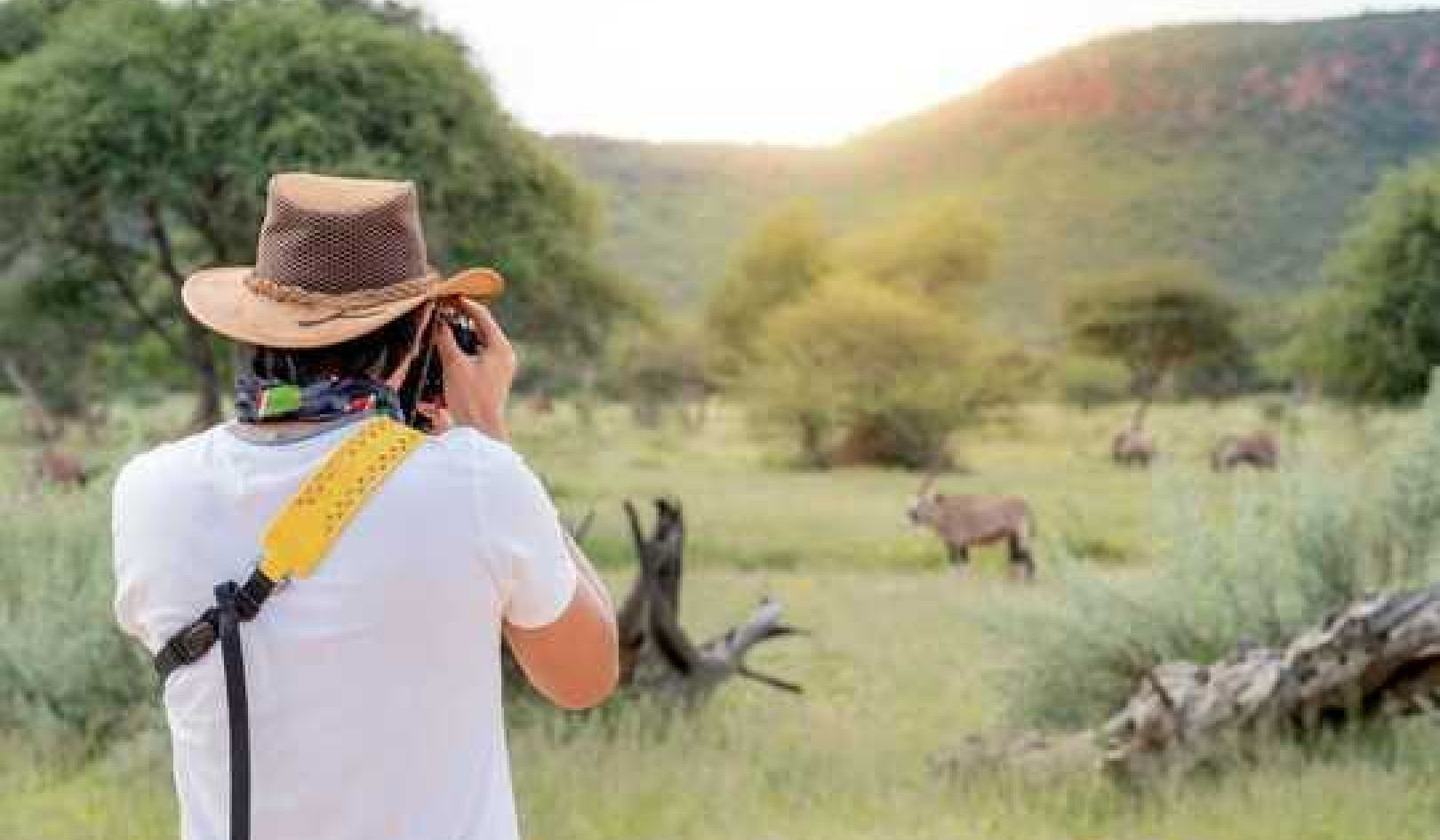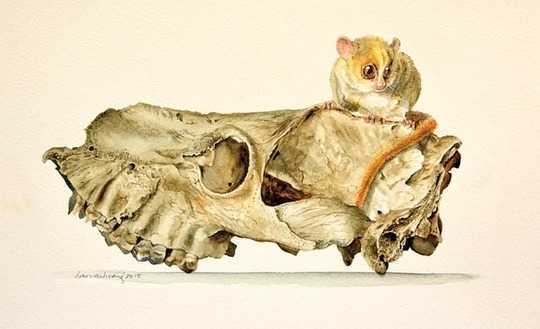 A modern mouse lemur Microcebus sits upon the cranium of an extinct Megaladapis lemur. Dao Van Hoang www.daovanhoang.com
A modern mouse lemur Microcebus sits upon the cranium of an extinct Megaladapis lemur. Dao Van Hoang www.daovanhoang.com
Giant 10-foot-tall elephant birds, with eggs eight times larger than an ostrich’s. Sloth lemurs bigger than a panda, weighing in at 350 pounds. A puma-like predator called the giant fosa.
They sound like characters in a child’s fantasy book, but along with dozens of other species, they once really roamed the landscape of Madagascar. Then, after millions of years of evolution in the middle of the Indian Ocean, the populations crashed in just a couple of centuries.
Scientists know that over the past 40,000 years, most of Earth’s megafauna – that is, animals human-size or larger – have gone extinct. Woolly mammoths, sabre tooth tigers and countless others no longer roam the planet.
What’s remarkable about the megafaunal crash in Madagascar is that it occurred not tens of thousands of years ago but just over 1,000 years ago, between A.D. 700 and 1000. And while some small populations survived a while longer, the damage was done in a relatively short amount of time. Why?
Over the last three years, new investigations into climate and land use patterns, human genetic diversity on the island and the dating of hundreds of fossils have fundamentally changed scientists’ understanding of the human and natural history of Madagascar. As two paleoclimatologists and a paleontologist, we brought together this research with new evidence of megafaunal butchery. In doing so we’ve created a new theory of how, why and when these Malagasy megafauna went extinct.
Climate at the time of the crash
The first job is to understand exactly when the megafauna died out.
Radiocarbon dating of over 400 recent fossils demonstrates that animals under 22 pounds lived on Madagascar throughout the last 10,000 years. For animals over 22 pounds, there are abundant fossils up to 1,000 years ago, but relatively few since. The biggest decline in number of large animals occurred rapidly between A.D. 700 and 1000 – practically instantaneous given the long history of their existence on the island.
What was the climate doing at that time? One popular theory for the megafaunal extinction has blamed island-wide drying. To test this idea, our team has been exploring the caves of Madagascar, collecting and analyzing stalagmites. As stalagmites grow upwards from the cave floor, layer by layer, differences in the chemistry of each layer document changes in the climate outside the cave.
By analyzing chemical composition and comparing ratios of various isotopes in these stalagmites, we created new high-resolution records of changes in the Malagasy ecosystems and climate. We found minor fluctuations in the strength of the summer rains throughout the last 2,000 years, but no significant drying over that period. In fact, A.D. 780-960 was one of the wettest periods of the last 2,000 years. Chemical analyses of fossils back up this claim.
So it looks like there was no significant drying around the time the megafauna disappeared.
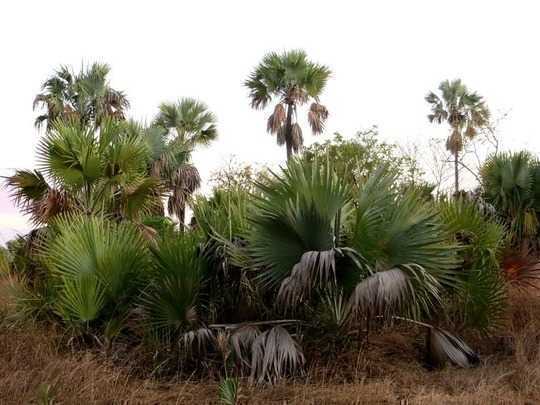 Many of the forests that originally existed on Madagascar are now replaced by more open, human-modified landscapes, like this palm savanna at Anjohibe. Laurie Godfrey, CC BY-ND
Many of the forests that originally existed on Madagascar are now replaced by more open, human-modified landscapes, like this palm savanna at Anjohibe. Laurie Godfrey, CC BY-ND
Instead, the stalagmite records indicated a rapid and dramatic change in the landscape. Changing ratios of the isotopes carbon-12 to carbon-13 reveal a switch from forests to grassland right around A.D. 900, the same time as the megafaunal population crash. Clearly something big happened around this time.
Cut marks and evidence of butchery
With no significant change in the climate, some point to the arrival of humans on the island as a possible cause of the megafauna population crash. It seems logical that once people arrived on Madagascar, they might have hunted the big animals into extinction. New data suggest that this timing doesn’t add up, though.
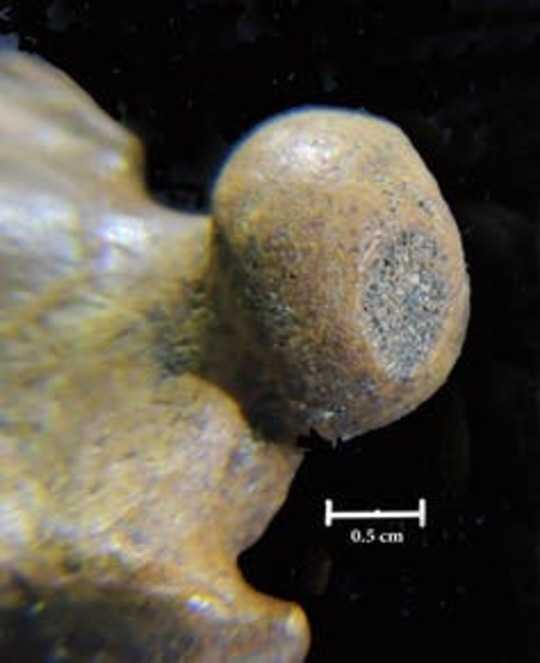 One of two chop marks on the head of a femur of an extinct lemur, Pachylemur. This individual’s hind limb was removed from the trunk at the hip joint, probably with a machete. Lindsay Meador, CC BY-ND
One of two chop marks on the head of a femur of an extinct lemur, Pachylemur. This individual’s hind limb was removed from the trunk at the hip joint, probably with a machete. Lindsay Meador, CC BY-ND
According to new dates on fossil bones with cut marks on them, humans arrived on Madagascar 10,500 years ago, much earlier than previously believed. But whoever these early people were, there’s no genetic evidence of them left on the island. New analysis of the human genetic diversity in modern Madagascar suggests the current population derives primarily from two waves of migration: first from Indonesia 3,000 to 2,000 years ago, and later from mainland Africa 1,500 years ago.
So it seems that people lived alongside the megafauna for thousands of years. How did the humans interact with the large animals?
Our new study found dozens of fossils with butchery marks. Cut and chop marks provide compelling evidence as to which species people were hunting and eating. Evidence of butchery of animals that are now extinct continues right up to the time of the megafaunal crash. Some people on Madagascar hunted and ate the megafauna for millennia without a population crash.
Evidence for a change in land use
If there was no obvious climate shift and humans lived alongside and sustainably hunted the megafauna for up to 9,000 years, what could have triggered the population crash?
The abrupt land use change might hold some clues. The transition from a forest-dominated ecosystem to a grassland-dominated ecosystem appears to be widespread. Scientists have identified this switch not only in the chemical signature of stalagmites but also in pollen grains buried in layers of mud at the bottom of lakes. Ancient lake sediments reveal two other changes occurred at the same time as the shift to grass species: an increase in charcoal from fires and an increase in the fungus Sporormiella, which is associated with the dung of large herbivores such as cows.
Evidence for simultaneous increases in grassland, fires, and cows and other domesticated animals points to a sudden change in Malagasy lifestyle: the introduction of cattle husbandry and slash-and-burn agriculture known locally as Tavy. Here, forests are cut down to make space for rice paddies, and grassland burned to promote the growth of nutritious seedlings for cow fodder.
This move away from foraging and hunting toward farming meant the land could support more people. The result was a rapid rise in the size of the human population – and that’s what we conclude spelled disaster for the megafauna.
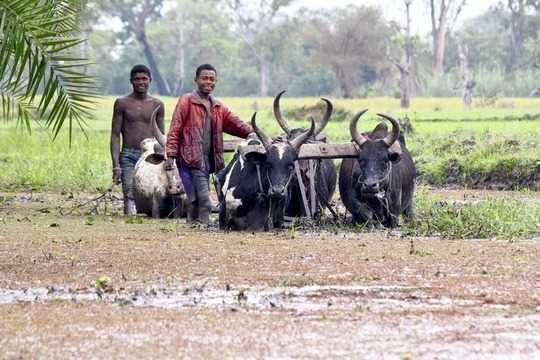 Some Malagasy farmers plow agricultural fields in the traditional way. Damian Ryszawy/Shutterstock.com
Some Malagasy farmers plow agricultural fields in the traditional way. Damian Ryszawy/Shutterstock.com
Here lies the contradiction of the situation: Hunting megafauna for survival became less important as people could rely on their agriculture and livestock. But cut marks on fossil bones indicate that hunting didn’t altogether stop just because people had other food sources. It turns out that the impact on the megafauna of larger human populations hunting just to supplement their diet was greater than the impact of smaller human populations relying more heavily on the native animals as a vital food source.
Bringing together new data on land use changes, climatic histories, genetics, fossil ages and butchery of the megafauna, we call this change “the subsistence shift hypothesis.” Both the habitat loss and increase in human population arose out of a fundamental change in the way humans lived on Madagascar, from a more nomadic hunter-gatherer lifestyle to an agrarian society. We argue that it was this reorganization on Madagascar around A.D. 700-1000 that led to the crash in the megafaunal population.
Small populations of megafauna lived on in isolated pockets for another few centuries, but their fate was likely already sealed. The majority of the giant birds and animals that were once common across our planet have gone extinct. Many of the remaining giants, such as elephants and rhinos, are threatened or endangered. Will they go the same way as the Malagasy megafauna, casualties of humans’ changing lifestyles?![]()
About The Authors
Nick Scroxton, Postdoctoral Research Scholar in Paleoclimatology, University of Massachusetts Amherst; Laurie Godfrey, Emeritus Professor of Anthropology, University of Massachusetts Amherst, and Stephen Burns, Professor of Geosciences, University of Massachusetts Amherst
This article is republished from The Conversation under a Creative Commons license. Read the original article.
Books on The Environment from Amazon's Best Sellers list
"Silent Spring"
by Rachel Carson
This classic book is a landmark in the history of environmentalism, drawing attention to the harmful effects of pesticides and their impact on the natural world. Carson's work helped to inspire the modern environmental movement and remains relevant today, as we continue to grapple with the challenges of environmental health.
Click for more info or to order
"The Uninhabitable Earth: Life After Warming"
by David Wallace-Wells
In this book, David Wallace-Wells offers a stark warning about the devastating effects of climate change and the urgent need to address this global crisis. The book draws on scientific research and real-world examples to provide a sobering look at the future we face if we fail to take action.
Click for more info or to order
"The Hidden Life of Trees: What They Feel, How They Communicate?Discoveries from A Secret World"
by Peter Wohlleben
In this book, Peter Wohlleben explores the fascinating world of trees and their role in the ecosystem. The book draws on scientific research and Wohlleben's own experiences as a forester to offer insights into the complex ways that trees interact with one another and the natural world.
Click for more info or to order
"Our House Is on Fire: Scenes of a Family and a Planet in Crisis"
by Greta Thunberg, Svante Thunberg, and Malena Ernman
In this book, climate activist Greta Thunberg and her family offer a personal account of their journey to raise awareness about the urgent need to address climate change. The book provides a powerful and moving account of the challenges we face and the need for action.
Click for more info or to order
"The Sixth Extinction: An Unnatural History"
by Elizabeth Kolbert
In this book, Elizabeth Kolbert explores the ongoing mass extinction of species caused by human activity, drawing on scientific research and real-world examples to provide a sobering look at the impact of human activity on the natural world. The book offers a compelling call to action to protect the diversity of life on Earth.




















